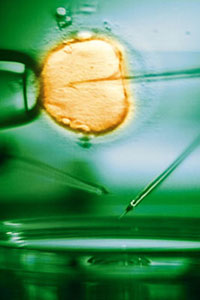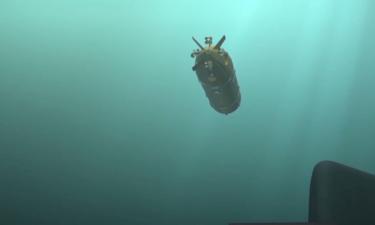Infertility is not the reason for couples to break up
A portion on donor sperm in Russia costs $100
At the end of the 18th century, English surgeon John Hunter put a man's sperm into his wife's uterus manually to help the sterile couple have babies. In nine months, the woman delivered a healthy baby, but the society, the church and the woman's husband turned against the doctor. Today, about 30,000 babies come to the world thanks to artificial insemination every year, and this method seems to be a wonderful solution of the problem of infertility.
In all epochs infertility was a real tragedy for couples, especially women. The patriarchal traditions and ignorance of conception mechanisms usually resulted in blaming women for the failure to become pregnant. In Ancient Rome, any men could easily divorce his wife if he suspected her of being sterile. When Aristotle suggested that males sometimes could be also guilty of sterility at times, men made a laughing-stock of him. And the situation did not radically change for the better when Christianity settled.
In 1827, researcher Karl Ber from St.Petersburg found out that both man and women alike were responsible for successful pregnancy because conception requires fusion of a spermatozoon and an ovule. The discovery partially rehabilitated women as concerning charges of fertility and made fighting sterility more effective. Since that time doctors usually examine both partners complaining of fertility.
At the end of the 20th century when subsidiary reproductive technologies were applied doctors managed to make every fourth artificial insemination result in pregnancy. As of today, doctors offer about ten subsidiary reproductive technologies that can be applied depending upon the reason of fertility of every particular couple.
Doctors say that spermogram of a healthy fertile man contains at least two million spermatozoa and half of them must be active and valid. If a husband has not enough active spermatozoa the couple may be offered the artificial insemination procedure. Under sterile conditions the sperm of a man is cleared of admixtures and nonviable cells and then put into the wife's uterus. Next the process will develop its natural way: the most active spermatozoon will meet an ovule and impregnate it.
It may happen that the ejaculate of a man contains no active spermatozoa or sperm ejaculation is abnormal at all. Then doctors employ more complex artificial insemination methods when men sometimes have to undergo micro operations. As a result of such operations doctors obtain spermatozoa but the amount is not enough to perform the traditional artificial insemination. In this case, patients have extracorporal fertilization: during the procedure an embryo conceived in a lab tube is introduced into a woman's uterus. Getting ready for the procedure and extracorporal fertilization may take about two weeks. Geneticists carefully watch if an embryo conceived in a lab has no defects and only after that introduce it into a woman's uterus. Women become pregnant in 20-25 per cent of extracorporal fertilization operations while naturalinsemination is a success in 30 per cent of instances. During the procedure women get several fertilized ovules introduced into the uterus, thus they are highly likely to deliver twins or even triplets.
Every clinic practicing subsidiary reproductive technologies has a sperm bank where active donor sperm is kept frozen. Men wishing to become sperm donors must be of the age between 20 and 40 and have healthy children. Before the procedure, donors do a blood test to see if there is no infection in blood; doctors also study spermograms of all donors. The technologies applied for artificial insemination with donor sperm or with the sperm of a woman's husband are similar.
When a man has good spermogram but his wife still cannot become pregnant, the problem lies in her health. The female genital system is more complicated than that of men; it may take doctors months and even years to find out why a woman cannot become pregnant. Often, women cannot become pregnant because of occlusion of fallopian tubes, ovule maturation failures, hormonal problems and metabolic diseases.
Women are prescribed artificial insemination when spermatozoa cannot pass through the cervical canal of uterus. Extracorporal insemination suits for women with blocked fallopian tubes and an ovule thus cannot meet a spermatozoon.
Doctors recommend using donor ovules if women are sterile because their ovules are defective or they have no ovules at all. Such ovules are impregnated with spermatozoa of a woman's husband and then implanted into her uterus. In some cases couples have bad inheritance or they are genetically incompatible, and doctors recommend using both donor ovules and donor sperm.
Using a surrogate mother is now the most disputable type of artificial insemination. Some other woman allows a sterile couple to use her reproductive system for carrying of a pregnancy and delivery of a baby. Doctors put ovules of a wife into some other woman's uterus after insemination with her husband's spermatozoa in a lab. Using a surrogate mother often entails psychological, financial and juridical problems. But this is the only way for women with defective or ablated uterus to have babies.
For many years already researchers have been trying to estimate if there is any difference between babies conceived in a natural way or by means of artificial insemination. Majority of researchers state that immune system, mental and physical health of all children are approximately similar. At that, experts add that children who come into the world thanks to artificial insemination are more tactful towards their parents and easier contact people.
In Russia, single artificial insemination with husband's sperm costs approximately $170, with donor sperm – approximately $340. Extracorporal insemination costs $1,000 – 1,500, the same procedure with donor ovules costs $1,300-2,700, with donor sperm - $1,100 – 2,700. Donor sperm costs $100.
Discuss this article on Pravda.Ru ENGLISH FORUM
Subscribe to Pravda.Ru Telegram channel, Facebook, RSS!





